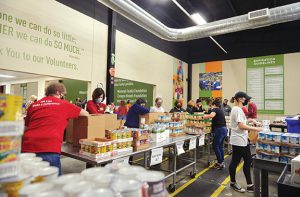Bloomberg
American families are feeling the financial squeeze of soaring inflation and a persistent pandemic as fractious Democrats return to Washington this week no closer to a deal on a tax and spending bill party leaders hoped would by now provide relief.
Despite gangbusters growth at a 6.9% annual rate during the final quarter of 2021, other economic measures tell a very different story. Average wages are falling behind inflation and consumer sentiment plummeted in January to the lowest in more than a decade.
More Americans are having trouble paying their bills than at any time since last March, shortly before the Biden administration began distributing stimulus checks and other relief measures. Hunger is rising again.
It’s an ominous start to a midterm election year for Democrats struggling to hold on to razor-thin majorities in Congress. President Joe Biden began his term with ambitions to address long-festering economic inequalities and lift prospects for the poor and middle class but an intra-party rift has halted progress on his centerpiece tax and social spending plan.
The financial squeeze many families feel may ease once the omicron wave subsides. But new progress remains vulnerable to Covid-19 variants, continued supply chain snarls and the Federal Reserve’s ability to reduce inflation without choking off growth too much. The public isn’t optimistic, with only a third in the University of Michigan Consumer Sentiment Index survey expecting the economy to improve in the year ahead.
Senators expect informal conversations to resume this week on Biden’s Build Back Better package, which was stymied in December after West Virginia Democrat Joe Manchin said he opposed it. With Republicans uniformly opposed and the Senate divided 50-50, Democrats need Manchin’s vote.
House Progressives Democrats have tried to set March 1 — the date of Biden’s first State of the Union address to Congress — as the latest deadline for a deal. But Speaker Nancy Pelosi cast doubt on that goal.
The consumer price index in December surged 7% from a year earlier, the highest annual increase in nearly 40 years.
The impasse halted a $2 trillion package of climate spending, assistance for child care and universal pre-school, and health care subsidies passed by the Democratic-controlled House, also ending a temporary monthly child care tax credit that Biden had hoped to extend.
Almost 23 million American adults in early January didn’t have enough food to eat during the previous 7 days, nearly 2 million more than a month earlier and 6 million more than in August, according to the Census survey.
The diverging experiences of the well-off and those with modest means are reflected in the University of Michigan index. Perceptions improved by 1.8% from December among families with annual incomes of at least $100,000 while they plunged 11% among those making less.
Rising food and energy costs have hit lower-income Americans hardest since they spend a much larger share of their
income on food, gasoline and utilities.
Biden suggested at a news conference earlier this month that the child tax credit may need to be dropped from the package to win passage in the Senate. That prompted a group of Democratic senators, led by Colorado’s Michael Bennet, to demand the benefit be retained as the centerpiece of the bill.
Other Democrats have indicated they are open to lowering the income level for eligibility to get Manchin on board, though that would conflict with Biden’s pledge not to raise taxes on families making less than $400,000.
Even before the first missed payment of the child tax credit in mid-January, the financial situation was worsening for many at the bottom of the economic ladder. Some 72 million American adults were having difficulty paying usual household bills by early January, up 3 million from a month earlier and 12 million more than in August, according to US Census estimates based on its Household Pulse survey.
At the same time, the financial toll of the delta and omicron waves of the pandemic has been worse for lower-income people, who are more likely to work in jobs that cannot be done remotely. They are also less likely to have sick pay or resources to fall back on if their employment is interrupted by quarantine, illness or closing of a child’s school or daycare.
By early January, more than 8.7 million Americans missed work the prior week because they were sick with Covid-19 or caring for someone with the illness. Workers with a high school education or less were more than 3 times as likely to experience such covid-related absences as college graduates, according to the most recent Census survey, conducted Dec. 29 through January 10.
Many low-income families were already depleting modest savings they built up after the spring stimulus payments as other pandemic supports were withdrawn, including enhanced unemployment benefits. By late October, lower-income bank customers had used up a median of 64% of gains in account balances after the stimulus payments, according to an analysis by the J.P. Morgan Chase Institute.
“If you’re living on the edge, it doesn’t take much to push you over. And five days pay is a lot,†Sahm said. “For some families, it’s a crisis. Something doesn’t get paid.â€
 The Gulf Time Newspaper One of the finest business newspapers in the UAE brought to you by our professional writers and editors.
The Gulf Time Newspaper One of the finest business newspapers in the UAE brought to you by our professional writers and editors.
